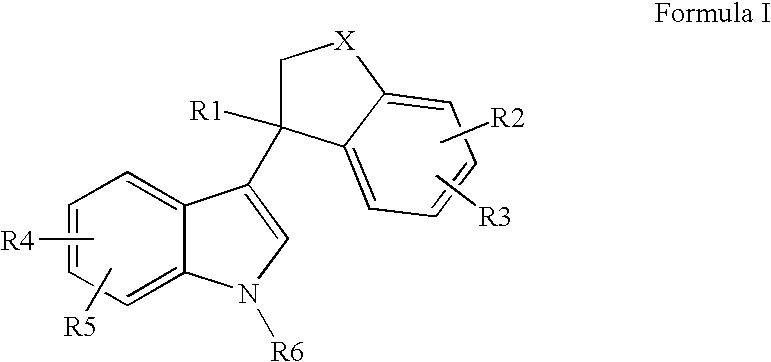Bicyclic substituted indole-derivative steroid hormone nuclear receptor modulators
a steroid hormone and nuclear receptor technology, applied in the field of bicyclic substituted indole-derived steroid hormone nuclear receptor modulators, can solve the problems of hyperglycemia, diabetes mellitus, hyperglycemia, etc., and achieves the effects of increasing water retention, increasing sodium retention, and increasing magnesium and potassium excretion
- Summary
- Abstract
- Description
- Claims
- Application Information
AI Technical Summary
Problems solved by technology
Method used
Image
Examples
preparation 1
1-Ethyl-5-fluoro-indan-1-ol
[0214]
Add ethyl magnesium bromide (1.3 ml, 3.90 mmol, 1.30 equivalents, 3.0 M in tetrahydrofuran) drop wise to a solution of 5-fluoroindanone (450 mg, 3.00 mmol) in. anhydrous ether (5 ml) under nitrogen at room temperature and stir overnight. Quench the reaction by drop wise addition of 10% aqueous ammonium chloride, dilute with ether, wash with water (2×), dry over anhydrous sodium sulfate, filter, and concentrate to obtain the'title compound (502 mg, 93%). NMR (400 MHz, CDCl3): δ 0.94 (t, 3H), 1.79(m, 1H), 1.92 (m, 1H), 2.12 (m, 1H), 2.31 (m, 1H), 2.81 (m, 1H), 2,98 (m, 1H), 6.91 (m, 2H), 7.24 (m, 1H).
preparation 2
(2-Carboxy-ethyl)-triphenyl-phosphonium bromide
[0215]
Reflux a solution of triphenylphosphine (91.3 g, 348 mmol, 1.05 equivalents) and 3-bromopropionic acid (50.7 g, 331 mmol) in acetonitrile (250 ml) for three hours, allow to sit at room temperature overnight. Add ether (400 ml) and cool in the freezer for two hours. Filter solids, rinse with ether, and dry solids under high vacuum to obtain the title compound (94.1 g, 68%). NMR (400 MHz, CDCl3): δ 3.15 (m, 2H), 3.73 (m, 2H), 7.69-7.83 (m, 15H).
preparation 3
4-(3-Fluoro-phenyl)-but-3-enoic acid
[0216]
To a suspension of 3-fluoroaldehyde (13.4 ml, 126 mmol) and (2-carboxy-ethyl)-triphenyl-phosphonium bromide (62.85 g, 151 mmol, 1.20 equivalents) in anhydrous dichloromethane (150 ml) at 0° C. under nitrogen add potassium t-butoxide portion wise (315 mmol, 2.50 equivalents) over two hours and stir at room temperature overnight. Dilute with water, wash with dichloromethane (2×), acidify the aqueous layer with 1N hydrochloric acid to pH 1, dilute with ether, wash with water (2×), dry over anhydrous sodium sulfate, filter, and concentrate to obtain the title compound (24.28 g, ˜99%, contains approximately 1.6 g triphenylphophine oxide). NMR (400 MHz, CDCl3): δ 3.26 (d, 2H), 6.32 (m, 1H), 6.48 (d, 1H), 6.95 (t, 1H), 7.08 (d, 1H), 7.14 (d, 1H), 7.27 (m, 1H). The product is a 95:5 EZ mixture.
PUM
| Property | Measurement | Unit |
|---|---|---|
| volume | aaaaa | aaaaa |
| volume | aaaaa | aaaaa |
| volume | aaaaa | aaaaa |
Abstract
Description
Claims
Application Information
 Login to View More
Login to View More - R&D
- Intellectual Property
- Life Sciences
- Materials
- Tech Scout
- Unparalleled Data Quality
- Higher Quality Content
- 60% Fewer Hallucinations
Browse by: Latest US Patents, China's latest patents, Technical Efficacy Thesaurus, Application Domain, Technology Topic, Popular Technical Reports.
© 2025 PatSnap. All rights reserved.Legal|Privacy policy|Modern Slavery Act Transparency Statement|Sitemap|About US| Contact US: help@patsnap.com



